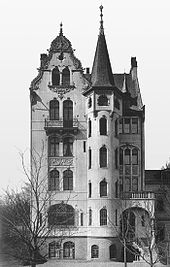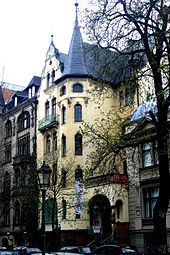Villa Grisebach
The Villa Grisebach is an urban villa built in 1891/1892 by the architect Hans Grisebach for himself as a studio and residential building on Fasanenstrasse in Berlin-Charlottenburg . It is part of the so-called winter garden ensemble , which has been a listed building since 1981 , which also includes the neighboring Käthe Kollwitz Museum and the Literaturhaus Berlin , and is now home to the Villa Grisebach auction house.
Grisebach's style and building history
With his villa, Grisebach designed a new type of house in Berlin. He didn't want to live in an apartment or in a suburban villa. His narrow house is built right up against the sidewalk. The garden is behind the house. Functional materials linked to medieval designs were used. On the ground floor you come to a hall that connects to the first floor with a winding staircase in dark oak. He built from the inside out, and the facade conformed to these plans. The rooms were not accessed through a central corridor, but from room to room. The building is "longitudinally rectangular" and the doors of the rooms are staggered. There are several rooms on each of the four floors.
Soon after Grisebach's death, the villa was sold and then rebuilt. During the Second World War, the Villa Grisebach was so destroyed that the facade was preserved, but the villa was no longer habitable until the 1960s. In the 1960s, the villa was threatened to be demolished in favor of a project to tunnel under the area around Kurfürstendamm from Lietzenburger to Hardenbergstrasse. In 1980, the listed building at Fasanenstrasse 25 was restored by the patronage of Deutsche Bank. The Villa Grisebach Auctions has been the owner of the house since 2013.
The auction house
Grisebach (until autumn 2015 Villa Grisebach Auctions ) has grown into an important German auction house for German and international art of the 19th century since it was founded by the five art dealers Bernd Schultz, Hans Pels-Leusden, Wilfried Utermann, Raimund Thomas and Michael Neumann in 1986 . , 20th and 21st centuries with a focus on classical modernism . Auctions are held twice a year, each with at least seven auctions.
Grisebach is led by the managing directors Diandra Donecker, Micaela Kapitzky, Markus Krause and Rigmor Stüssel.
The auction house initially limited itself to an art-historical area. According to the company, over 2500 art lovers came to the first preview in November 1986. The turnover at this auction was over DM 4 million. Grisebach was already in the black in the first year. In 2006, Grisebach had six of the ten most expensive works of art at German auctions. The turnover in 2004 was 26.2 million euros, in 2006 it rose to 45 million euros. In the 2017 financial year, the turnover of the company Grisebach GmbH amounted to EUR 11.7 million. Since 1988, Grisebach has been the highest-turnover auction house for modern art in Germany and the market leader for German art of the 20th century.
Grisebach has its own offices in Munich , Düsseldorf , Zurich and New York . In addition, representatives represent the auction house in Hamburg, Bielefeld, Dortmund, Frankfurt am Main and Stuttgart as well as in Paris, Rome and Los Angeles.
From 2011 to 2018, the art historian, journalist and author Florian Illies ran the auction house as one of the four shareholders, having previously headed the feature section and literature of the time . At Grisebach, he was primarily committed to the art of the 19th century, with the aim of thematically expanding the auction house, which had previously specialized in classical modern art.
literature
- John Lochner-Griffith: The Grisebach house on Fasanenstrasse - the villa in the narrow area . In: Deutsche Bank AG (ed.): Stadtvilla Grisebach and Käthe-Kollwitz-Museum . 2nd edition 2005, pp. 13-27.
Web links
Individual evidence
- ↑ Diandra Donecker: A 30-year-old is the new boss at the Grisebach auction house. Retrieved September 3, 2019 .
- ↑ Diandra Donecker succeeds Florian Illies at Grisebach | Monopoly. Retrieved September 3, 2019 .
- ↑ a b Federal Gazette. Retrieved September 3, 2019 .
- ↑ Philosophy and History. Retrieved September 3, 2019 .
- ↑ The long breath. Retrieved September 3, 2019 .
- ^ Corinna Daniels: "Great art is a growth market" . March 20, 2003 ( welt.de [accessed September 3, 2019]).
- ↑ Swantje Karich: The most expensive German auctions 2006: Red horses, yellow houses and a closet . ISSN 0174-4909 ( faz.net [accessed September 3, 2019]).
- ^ Villa Grisebach | ArtBerlin.de. Retrieved September 3, 2019 (German).
- ^ Westdeutsche Zeitung: Art trade: auction giant in the Carlstadt. Retrieved September 3, 2019 .
- ↑ "The art trade must not be demoned". Retrieved September 3, 2019 .
- ^ Rose-Maria Gropp: The German auction year 2015: From good works . ISSN 0174-4909 ( faz.net [accessed September 3, 2019]).
- ↑ German art market with 18 percent increase in sales. Retrieved September 3, 2019 .
- ↑ CH_Zuerich. Retrieved September 3, 2019 .
- ↑ USA / Canada. Retrieved September 3, 2019 .
- ↑ Representatives. Retrieved September 3, 2019 .
- ↑ Generation art. In: FAZ . December 17, 2010, p. 34.
- ↑ Gabriela Walde: Florian Illies leaves the Villa Grisebach. July 16, 2018, accessed on September 3, 2019 (German).
- ^ Angela Hohmann: Grisebach auction house: Florian Illies' quiet exit - Culture - Tagesspiegel. In: tagesspiegel.de. July 16, 2018, accessed August 2, 2018 .
- ↑ Sebastian Preuss: Florian Illies - From top journalist to art dealer , Berliner Zeitung, November 22, 2011
Coordinates: 52 ° 30 ′ 5.7 ″ N , 13 ° 19 ′ 36.4 ″ E

